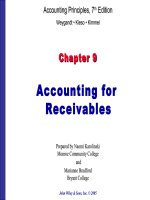Accounting principles 11e kieso kimmel chapter 007
Bạn đang xem bản rút gọn của tài liệu. Xem và tải ngay bản đầy đủ của tài liệu tại đây (2.24 MB, 45 trang )
Prepared by
Coby Harmon
University of California, Santa Barbara
Westmont College
7-1
7
Accounting Information
Systems
Learning Objectives
After studying this chapter, you should be able to:
[1] Identify the basic concepts of an accounting information system.
[2] Describe the nature and purpose of a subsidiary ledger.
[3] Explain how companies use special journals in journalizing.
7-2
Preview of Chapter 7
Accounting Principles
Eleventh Edition
Weygandt Kimmel Kieso
7-3
Basic Concepts of AIS
Accounting information system (AIS) collects and
processes transaction data and communicates financial
information to decision makers.
Includes:
7-4
All steps in the accounting cycle.
Documents that provide evidence of transactions.
Manual or computerized accounting system.
LO 1 Identify the basic concepts of an accounting information system.
Basic Concepts of AIS
Cost Effectiveness - Benefits
must outweigh the costs.
Illustration 7-1
Principles of an efficient
and effective AIS.
Useful
Output
Flexibility - The system should
be sufficiently flexible to meet
the resulting changes in the
demands made upon it.
7-5
LO 1 Identify the basic concepts of an accounting information system.
Basic Concepts of AIS
Computerized Accounting Systems
7-6
Software programs (functions include sales, purchases,
receivables, payables, cash receipts and disbursements,
and payroll).
Generate financial statements.
Advantages:
►
Typically enter data only once.
►
Many human errors are eliminated.
►
More timely information.
LO 1 Identify the basic concepts of an accounting information system.
Basic Concepts of AIS
Computerized Accounting Systems
Choosing a software package.
Entry-Level Software.
7-7
►
Easy data access and report preparation
►
Audit trail
►
Internal control
►
Customization
►
Network Compatibility
Enterprise Resource Planning Systems.
LO 1 Identify the basic concepts of an accounting information system.
7-8
Basic Concepts of AIS
Manual Accounting Systems
7-9
Perform each step in the accounting cycle by hand.
Satisfactory with a low volume of transactions.
Must understand manual accounting systems to
understand computerized accounting systems.
LO 1 Identify the basic concepts of an accounting information system.
Subsidiary Ledgers
Used to keep track of individual balances.
Two common subsidiary ledgers are:
1. Accounts receivable (customers’)
2. Accounts payable (creditors’)
7-10
Illustration 7-2
Relationship of general ledger
and subsidiary ledgers
LO 2 Describe the nature and purpose of a subsidiary ledger.
Subsidiary Ledgers
7-11
Illustration 7-2
Relationship of general and
subsidiary ledgers
LO 2
Subsidiary Ledgers
Advantages of Subsidiary Ledgers
1. Show in a single account transactions affecting one
customer or one creditor.
2. Free the general ledger of excessive details.
3. Help locate errors in individual accounts.
4. Make possible a division of labor.
7-12
LO 2 Describe the nature and purpose of a subsidiary ledger.
7-13
Special Journals
Used to record similar types of transactions.
Illustration 7-5
If a transaction cannot be recorded in a special journal, the
company records it in the general journal.
7-14
LO 3 Explain how companies use special journals in journalizing.
Special Journals
Question
Each of the following is a subsidiary ledger except the:
a. accounts receivable ledger.
b. accounts payable ledger.
c. customer’s ledger.
d. general ledger.
7-15
LO 3 Explain how companies use special journals in journalizing.
Special Journals
Sales Journal
Illustration 7-6
2014
Perpetual inventory system, one entry at selling price in Sales Journal results
in a debit to Accounts Receivable and a credit to Sales. Another entry at cost
results in a debit to Cost of Goods Sold and a credit to Inventory.
7-16
LO 3 Explain how companies use special journals in journalizing.
Special Journals
Posting the Sales Journal
2014
Illustration 7-7
2014
2014
2014
2014
7-17
Companies make daily postings from
the sales journal to the individual
accounts receivable in the
subsidiary ledger.
LO 3 Explain how companies use special journals in journalizing.
Special Journals
Posting the Sales Journal
2014
Illustration 7-7
2014
2014
2014
2014
7-18
Posting to the general ledger is done
monthly.
LO 3 Explain how companies use special journals in journalizing.
Special Journals
Proving the Ledgers
Illustration 7-8
7-19
LO 3 Explain how companies use special journals in journalizing.
Special Journals
Advantages of Sales Journal
7-20
One-line entry for each sales transaction saves time.
Only totals, rather than individual entries, are posted to
the general ledger.
A division of labor results.
LO 3 Explain how companies use special journals in journalizing.
Special Journals
Cash Receipts Journal
Illustration 7-9
2014
In the cash receipts journal, companies record all receipts of cash.
7-21
LO 3 Explain how companies use special journals in journalizing.
Special Journals
Posting
the Cash
Receipts
Journal
Not all of the
subsidiary or
general ledger
accounts are
shown on the
illustration to the
right. See
Illustration 7-9
for the complete
illustration.
7-22
Illustration 7-9
Illustration 7-9
Special Journals
Proving the Ledgers
7-23
Illustration 7-11
LO 3 Explain how companies use special journals in journalizing.
Special Journals
Question
Cash sales of merchandise are recorded in the
a. cash payments journal.
b. cash receipts journal.
c. general journal.
d. sales journal.
7-24
LO 3 Explain how companies use special journals in journalizing.
Special Journals
Question
Which of the following is not one of the credit columns in the
cash receipts journal:
a. Other accounts
b. Accounts payable
c. Accounts receivable
d. Sales
7-25
LO 3 Explain how companies use special journals in journalizing.









